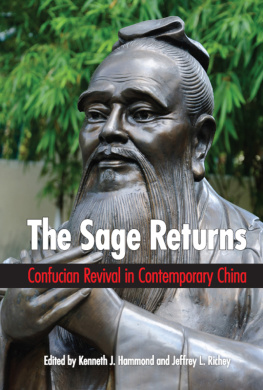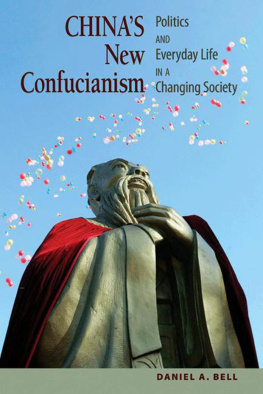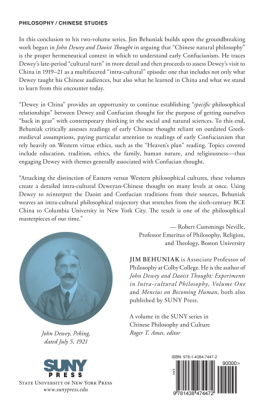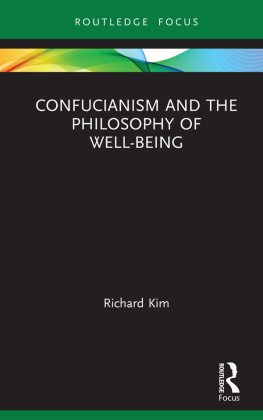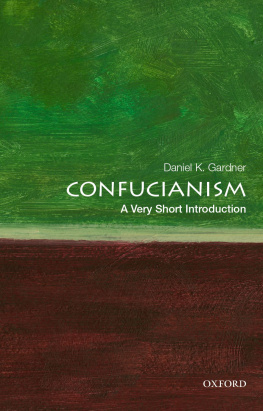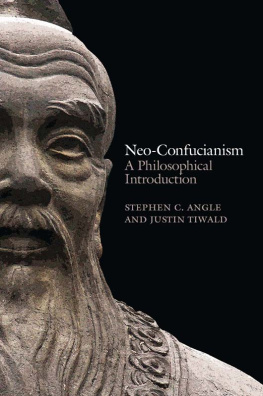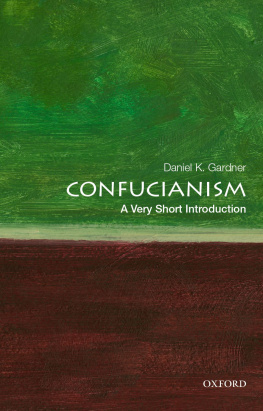The Sage Returns
SUNY series in Chinese Philosophy and Culture
Roger T. Ames, editor
The Sage Returns
Confucian Revival in Contemporary China
Edited by
Kenneth J. Hammond and Jeffrey L. Richey
Cover image from shutterstock.com
Published by State University of New York Press, Albany
2015 State University of New York
All rights reserved
Printed in the United States of America
No part of this book may be used or reproduced in any manner whatsoever without written permission. No part of this book may be stored in a retrieval system or transmitted in any form or by any means including electronic, electrostatic, magnetic tape, mechanical, photocopying, recording, or otherwise without the prior permission in writing of the publisher.
For information, contact State University of New York Press, Albany, NY
www.sunypress.edu
Production, Diane Ganeles
Marketing, Anne M. Valentine
Library of Congress Cataloging-in-Publication Data
The sage returns : Confucian revival in contemporary China / edited by Kenneth J. Hammond and Jeffrey L. Richey.
pages cm. (SUNY series in Chinese philosophy and culture)
Includes bibliographical references and index.
ISBN 978-1-4384-5491-7 (hardcover : alk. paper)
ISBN 978-1-4384-5493-1 (ebook)
1. ConfucianismChinaHistory21st century. I. Hammond, Kenneth James, editor. II. Richey, Jeffrey L., editor.
BL1853.S24 2015
10 9 8 7 6 5 4 3 2 1
Contents
Daniel A. Bell
Kenneth J. Hammond and Jeffrey L. Richey
Robert W. Foster
Jennifer Oldstone-Moore
Anthony DeBlasi
Kenneth J. Hammond
Jeffrey L. Richey
Robert L. Moore
Julia K. Murray
Illustrations
Foreword
On December 9, 2010, China awarded the Confucius Peace Prize to Lien Chan, Taiwans former vice-president, for having built a bridge between the mainland and Taiwan. The prize was awarded one day before the Nobel Peace prize honored the imprisoned Chinese dissident Liu Xiaobo. Outside China, the Confucius Peace Prize was widely derided as a crude attempt to counter the Nobel Prize. The Confucius Peace Prize also set off alarm bells that Confucianism is being officially promoted to justify an authoritarian form of government and to counter growing calls for political liberalization, similar to the way the Asian values discourse was used by the Singaporean government in the early 1990s to counter its pro-democracy critics.
Whatever the truth of such accusations, it would be wrong to indict Confucianism in China on the grounds that it is nothing but a slogan used to justify the political status quo and to counter social critics. This fascinating book demonstrates that the revival of Confucianism is taking place at different levels of society, often outside the governments sphere of authority. For example, Robert Moore shows that the Confucian ideal of harmony strongly influences family dynamics in China (in contrast to the United States).
Chinese media, as everybody knows, are subject to government control. But Anthony DeBlasis chapter shows that government interests must be increasingly balanced by consumer needs. And it turns out that there is substantial market demand for Confucianism, which helps to explain why it increasingly featured in the media. Several contributors discuss the Yu Dan phenomenon: a charismatic female academic who has sold millions of copies of a book on the Analects of Confucius. Julia Murray shows that new representations of Confucius have proliferated in a variety of media, including movies and animated cartoons. Murray adds that ordinary people prior to the twentieth century were not likely to encounter representations of Confucius, and Confucius himself did not have a popular following. In some ways, Confucianism may be more deeply embedded now than in Imperial Chinese history, when it was the official ideology of the state and promoted by male elite intellectuals but did not always impact the ordinary life of the masses.
This book also shows that the political uses of Confucianism are not always as conservative as they seem. While Yu Dans feel-good version may deflect attention from social problems, more politically minded Confucian-inspired critics pose substantial challenges to the status quo. In Imperial Chinese history, Confucianism served, as least intermittently, as a challenge to and check upon the abuse of power. Ken Hammonds contribution shows that Confucianism also serves similar purposes today. Hammond argues that there is a convergence between socialists who draw on Chinas political culture to promote a more just and equitable society and Confucians who seek to revive Confucianism as a basis for public life and political ethics within a modern socialist state.
Another important contribution of this book is that it sheds historical and comparative light on some of the reasons for the revival of Confucianism. Jennifer Oldstone-Moore shows that political leaders in Nationalist China drew on the language of scientists to promote Confucianism in the 1920s and 1930s. In the same vein, the Chinese Communist Party today has deemed Confucianism to be an appropriate working partner with scientific socialism that serves to promote a rational form of ethics. Robert Foster compares official support by the Chinese government to the promotion of Confucianism in Meiji Japan. However, what Foster calls popular Confucianism is driven more by psychological than political factors. Concern over moral decline that accompanies economic modernization motivates many social reformers. Jeffrey Richey shows that popular Confucianism is also supported by a growth in national pride and a search for identity that differ from Western-style ethics.
In short, this book deepens our thinking on the revival of Confucianism in China. It also opens up new questions. One of Confucianisms strengths is that it has demonstrated an amazing flexibility in assimilating the challenges of other value systems, from Daoism, Legalism, and Buddhism in the past to socialism, liberalism, and capitalism today. Obviously, Confucianism has changed via these repeated encounters with other traditions, but what exactly are the core values that underpin and survive these encounters? How precisely can core Confucian values help with educational, social, and political reform in China today? And what can Confucianism offer to the rest of the world today? This book provides the historical and sociological material that helps us to think about the answers in informed ways.
Daniel A. Bell
Beijing
Introduction
The Death and Resurrection of Confucianism
K ENNETH J. H AMMOND AND J EFFREY L. R ICHEY
In 2006, Yu Dan , a professor in Beijing Normal Universitys Department of Cinema, Television, and Media, published what became a runaway best-seller in China, Yu Dan Lunyu xinde ( Yu Dans Insights into the [Confucian] Analects), which transcribed the contents of her very popular television lecture series on China Central Television.
Why did a professors commentary on the teachings of Confucius sell upward of 10 million copies (in both official and pirated editions) in less than a year? Why did two middle-aged men willingly endure the hardship of carrying their elderly mother more than 4,500 kilometers (about 2,796 miles) on foot? Why does animal sacrifice to a long-dead Chinese sage play any role whatsoever in contemporary life? Why would the Chinese government erect a gigantic icon of the ancient thinker whom Mao Zedong once condemned as a feudal mummy just across from a fifteen-by-twenty-foot oil painting of Mao himselfand in Chinas largest public space, to boot? And why is all of this happening now, in the early twenty-first century, when Confucianism long ago was pronounced dead by Chinas Communist regime, not to mention a half-century of progressive-minded reformers who preceded Maos Communist revolution in 1949? The answers to these questions lie in the story of Confucianisms revival in contemporary China, which this volume seeks to tell as well as to understand.

